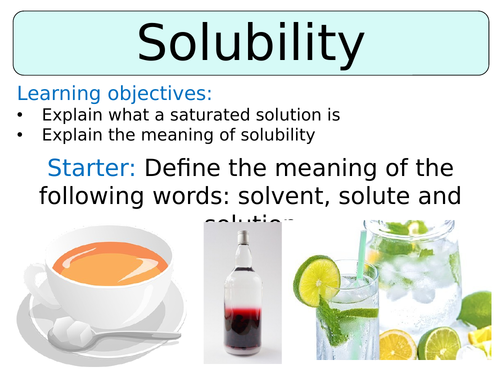
This lesson is designed for the KS3 Year 8 Science course, specifically the C2 1.3 unit on ‘Separation Techniques.
More Biology, Chemistry and Physics resources can be found in my TES Shop: https://www.tes.com/teaching-resources/shop/SWiftScience
The lesson begins with a ‘Think > Pair > Share’ task, students are asked to describe what happens when salt is mixed with water, using the particle model to help them with their explanation. After a short discussion, a diagram is revealed to show students what happens when more and more salt is added to water, eventually reaching a saturated solution.
Students will now be provided with a definition for ‘solubility’, following this students will complete a task whereby they will match the key word to the correct definition. Students can self-assess their work once this is complete.
Next, students will complete an investigation to work out how much sugar can be dissolved in 100g of water - an equipment list and method is provided for students to follow.
Students will now be given some data on the solubility of two salt compounds - potassium chloride and sodium chloride - as temperature increases from 0-100 degrees celsius. They will be required to draw a graph to display this data and describe the relationship between temperature and solubility. This work can be self-assessed once it is complete, using the mark scheme provided.
Lastly, students will complete a ‘copy and correct’ task where they will need to copy a paragraph into their books and make amendments so that it correctly summarises what students have learned this lesson.
The plenary task is a 3-3-1 reduction, students will need to write down three facts, three key words and 1 question to test their peers knowledge of what was learned this lesson.
All resources are included at the end of the presentation, thanks for looking, if you have any questions please let me know in the comments section and any feedback would be appreciated
Get this resource as part of a bundle and save up to 36%
A bundle is a package of resources grouped together to teach a particular topic, or a series of lessons, in one place.
Something went wrong, please try again later.
This resource hasn't been reviewed yet
To ensure quality for our reviews, only customers who have purchased this resource can review it
Report this resourceto let us know if it violates our terms and conditions.
Our customer service team will review your report and will be in touch.
